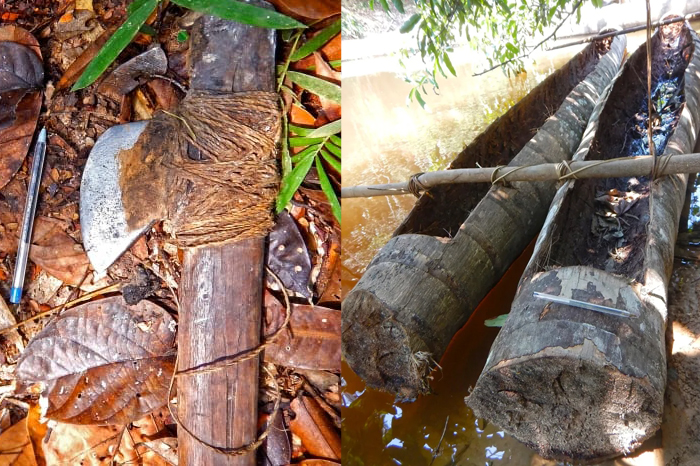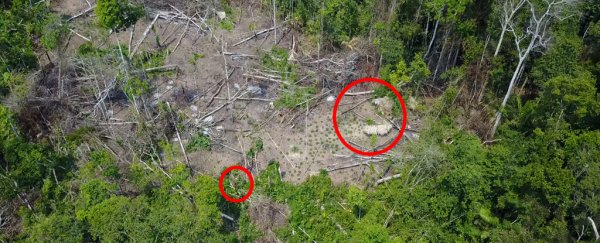A 2017 expedition into the depths of the Amazon rainforest has provided a rare glimpse into the lives of a small community of people who it's believed have no contact with the outside world.
As mindblowing as it is that pockets of humanity are still isolated from global economics, technology, and communications in the 21st century, the discovery reflects the challenge in studying a culture without interfering.
Aerial footage recently released by Brazil's National Indian Foundation (Fundação Nacional do Índio, or Funai) shows a clearing in the forest with a handful of figures walking through, seemingly oblivious to the camera hovering high overhead.
Check them out in the clip below.
Other snapshots taken by expedition members on the ground show images of canoes and hand tools created by an isolated community in the southwestern part of the Brazilian state of Amazonas.
Funai has been keeping a careful watch on this unnamed people for years, but this is the first time they've managed to discreetly record individuals on camera.
This region is home to more isolated tribes than anywhere else in the country. At least 19 communities in this part of the Amazon are confirmed to have had little to no contact with global cultures, cutting off all contact - often as a result of recent trauma.
Most appear to know there's more to the world than their corner of the rainforest – this isn't a case of a naive population that's simply yet to discover polyester, iPhones, and Coca Cola.
Funai says members of these communities seem to know of the agriculture and urban centres in their region.
"If they wanted contact with the outside world, they would seek out ways to communicate with us," Funai coordinator Bruno Pereira explained to the Associated Press.
They don't for a very simple reason – past encounters with the modern world have been less than peaceful.
Last year Funai released footage of a single individual who is thought to represent the last of his people.
One member of a previous expedition had been struck with one of his arrows, giving a good indication of this man's position on intercommunity relations.
And really, who can blame him? His family is thought to have been all but wiped out at the hands of mercenaries hired by illegal colonists and cattle ranchers.
His story is tragically too common. Another uncontacted tribe in western Brazil was reported to have been massacred by gold miners, who later bragged about their actions.
Perhaps the worst part is the world wouldn't have been any the wiser had they kept their mouths shut, hinting at the possibility of numerous other tribes vanishing without a whisper.
As isolated as that part of the world seems, the Amazon's vast ocean of trees hides networks of illegal activity run by people who have little regard for indigenous rights.
In order to protect those vulnerable communities, it helps to know what we can about their movements and culture.
That isn't easy if researchers are to keep at a safe distance. Beyond the ethics of making contact against the peoples' wishes, the risk of transmitting a communicable disease poses just a great a threat to their survival as violence.
Funai hasn't had contact with any members of Brazil's isolated communities for more than three decades.
Advances in technology are providing new opportunities to look deep inside territories and record activity without the risk of interference.
Drones were used to make a recording of people making their way through an area of felled trees. One can be seen carrying a spear or a small pole.
Other images released by Funai show a small axe, and a canoe on the shore of a riverbank.
 (Funai)
(Funai)
These snapshots of life might not seem like much, but gathering evidence safely and secretly helps build a picture of their way of life.
"The more we know about isolated communities' way of living, the more equipped we are to protect them," says Pereira.
They also serve to highlight the threats faced by uncontacted peoples in remote parts of the world.
There is hope. Another isolated people in Brazil's Yanomami territory were feared to have also fallen to the aggression of illegal mining. Aerial footage taken in 2016 revealed they were not only safe, but growing in numbers.
We can only hope this unnamed community faces a similarly strong and healthy future.
